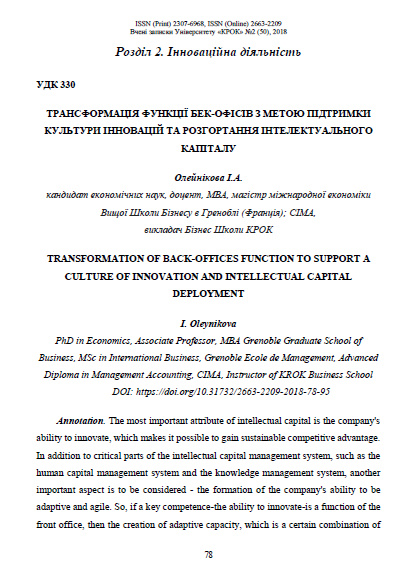Transformation of Back-Offices Function to Support a Culture of Innovation and Intellectual Capital Deployment
DOI:
https://doi.org/10.31732/2663-2209-2018-50-78-95Keywords:
intellectual capital, culture of innovation, back-office transformation, knowledge management system, performance, value added operationsAbstract
The most important attribute of intellectual capital is the company's ability to innovate, which makes it possible to gain sustainable competitive advantage. In addition to critical parts of the intellectual capital management system, such as the human capital management system and the knowledge management system, another important aspect is to be considered - the formation of the company's ability to be adaptive and agile. So, if a key competence-the ability to innovate-is a function of the front office, then the creation of adaptive capacity, which is a certain combination of human capital and a knowledge management system, manifests itself in a back-office meaning. The main back-office function is to support generation of innovations and their implementation through key competencies that ensure the rapid alterations of all processes and structures that are supposed to change. The main purpose of the research is to create company expertise, organizational structure, processes, performance measurement and a team that will be able to maintain steady changes and remain successful. It is obvious that the key component of such a company will be a well-formed team with the necessary skills, knowledge, and competencies, a team whose propensity for transformation is one of its basic characteristics, a team for which resistance to change is unacceptable. The goal of this research is to show how implementing culture of transformation in the back-office helps to promote innovations and improve the company's performance. Additionally, monetary assessment of back-office performance is done to demonstrate what exactly the business will receive in terms of market share, financial results, and company value.
Downloads
References
Turner G., Jackson-Cox J., 2002. "If management requires measurement how may we cope with knowledge?", Singapore Management Review, Vol. 24, No. 3, pp 101-111.
Minonne C., 2007. Towards an integrative approach for managing implicit and explicit knowledge: an exploratory study in Switzerland, Doctoral Dissertation, University of South Australia, Adelaide.
Turner G., Minonne C., 2009. "Measuring the effects of knowledge management practices", Conference proceedings of the 10th European Knowledge Management Conference, Vicenza, Italy, September.
Pfeffer J., 1997. "Pitfalls on the road to measurement: the dangerous liaison of human resources with the ideas of accounting and finance", Human Resource Management, Vol.36, No.3, pp 357-365.
Juergen H. Daum, “Intangible Assets and Value Creation” , Wilye, 2003
Edvinsson L. and Malone M.S. (1997). Intellectual Capital, Harper, London.
Edvinsson L., Malone M. (1997). Intellectual Capital: Realizing Your Com-pany’s True Value by Finding its Hidden Brainpower. New York: HarperBusiness.
Patricia Seemann, David De Long, Susan Stucky and Edward Guthrie titled “Building Intangible Assets: A Strategic Framework for Investing in Intellectual Capital”, Second International Conference on the Practical Applications of Knowledge Management (PAKeM99), 21-23 April, 1999.
Upton W. S. Jr., 2001. Challenges from the New Economy. Business and Financial Reporting, SPECIAL REPORT. Financial Accounting Standards Board. April. www.fasb.com.
Carol Corrado, Charles Hulten and Daniel Sichel, titled Measuring Capital and Technology (2005): An Expanded Framework, working paper prepared for the CRIW/NBER conference “Measuring Capital in the New Economy,” April 26-27, 2002, Washington, DC. 2002, revised 200.
Blaise M. Sonnier “Intellectual Capital Disclosure Practices of U.S. High Technology Companies and their Relationship to Performance, Value and Size metrics”, 2006.
Maditinos D., Chatzoudes D., Tsairidis C., Theriou G., 2011. The impact of intellectual capital on firms’ market value and financial performance. Journal of Intellectual Capital Vol. 12 No. 1 , 132-151.


